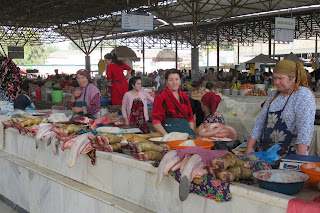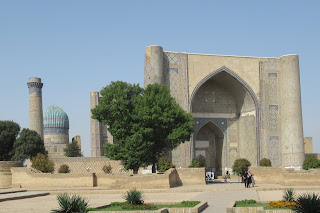 |
| The Samarkand Registan At Night |
Travel Dates 22nd-24th September 2019.
I arrived on the train from Tashkent a little after 9pm. Yandex has not reached Samarkand. In the chaos of the crowd leaving the station I was accosted by a cab driver offering to drive me to my guest house for US$10. I knew that was high and he swiftly dropped it to 50000 soʻm. I knew that was at least five times the going rate but I wasn't about to quibble about a seven dollar fare in the dark. He found the place after some confusion and we eventually arrived at guest house "Timur the Great". A forbidding locked high front gate faced me but they answered my knock swiftly. Apart from another rock-hard bed, corrected by adding comforters, it is excellent: a large modern room with a king-size bed for a single with breakfast included for US$25 per night. This is the alley behind the guest house in the old town.
Why am I here? Because the history fascinates me. Samarkand is one of the oldest cities of Central Asia. Traces of settlement appear as far back as the 7th or 8th century BCE. It had the Greek name Maracanda by the 4th century BCE, ruling Sogdiana. It was conquered by Alexander the Great in 329 BCE. Over the centuries since it has had a succession of conquerors: the Central Asian Turks (6th century CE); the Arabs (8th century); the Sāmānids (9th–10th century); various Turkic conquerors (11th–13th century); annexed by the Khwārezm-Shāh dynasty (early 13th century); then destroyed by Genghis Khan in 1220.
Amir Timur led the revolt against its Mongol rulers in 1365. He made Samarkand his capital and centre of an expanding empire as far south as northern India. It was again conquered by Uzbeks in 1500 and became part of the Khanate of Bukhara. By the 18th century Silk Road trade routes had moved to other cities and it had declined; from the 1720s to the 1770s it was uninhabited. Eventually it recovered when the next conquerors, the Russians, made it a provincial capital of the Russian Empire and a railroad centre in 1887. In the Soviet era It was briefly (1924–36) the capital of the Uzbek Soviet Socialist Republic. The surviving medieval old city is surrounded by a modern new city built since the Russian conquest.
I spent the morning wandering the Registan, Samarkand's most famous site. The guest house is a short walk from it. I did not realise I was entering from the wrong side and when I encountered a modest wall blocking my way I simply sat up on the wall, transferred my legs to the other side and walked on. It wasn't until I left after a couple of hours that I realised I had missed paying for entry. Oops. Nobody noticed, thankfully.
The Registan is massive, as you can see from the picture above. Registan originally meant a sandy area where people gathered but the name has continued to cover the site. The best description of the history I have read is on the Advantour web-site. In brief it is a set of three Madrassahs built over a period of about 250 years commencing in the early 15th century. A Madrassah was a learning centre.
The history of the site has similarities to the the fabulous Taj Mahal in that over the centuries as leaders changed and Samarkand declined in importance, at one stage to a population less than 2000, it fell into ruins. The change to Soviet rule was initially considered a disaster because use of the Madrassahs as learning centres was banned. But the Soviet rulers later became saviours of the structures as they encouraged renovation and restoration which was almost completed by the time of the collapse of the Soviet Union and re-establishment of Uzbekistan as an independent country. It is now of great importance to the tourist industry.
Unlike Evan's Knossos I had no problem with the reconstructions here or in other Uzbek locations. They appear to have been performed true to the original structures and decorations wherever possible. The old city has been accepted as a UNESCO World Heritage Centre.
I wandered awestruck. I'll let the pictures tell most of the story.
Many of the alcoves within the madrassahs sold souvenirs and local craft products.
After my visit to the Registan I intended seeing the Afrosiyob museum and site but discovered a cab driver who had less idea of its location than I did. By the time I realised we were driving in circles after nearly an hour I gave up, paid him off, and wandered an outer suburban neighbourhood until I found a tiny cafe. I ordered coffee with milk, no sugar and received one with sugar, no milk. The coffee culture of the Balkans has not reached Uzbekistan. Every time I ordered coffee I was offered instant, usually a combined sachet of coffee with sugar or with both sugar and creamer. I changed to chai: tea, usually green.
I had discovered Skype was unworkable from Uzbekistan. After lunch I spent some time finding a dealer to add cash to my sim card to allow calls home. Then I began wandering by cab and tram. The most difficult part of using the trams is discovering where the stops are and hoping the traffic stops and allows you to get on. A ride to the end of the line is 1400 soʻm (about 22c).
I attended the sound and light show on my first night but had not planned for a bitterly cold wind, after day temperatures in the mid-30s C, and left early. I obtained better pictures on the second night.
I looked for restaurants where the locals ate for lunch; this was near the Siyob market for a bowl of nourishing soup and a beer.
This was a typical bread oven being used for small buns in this case.
I usually ate dinner in local restaurants for about 30000 soʻm (~$5) including drinks. Language difficulties can have interesting results. For example I thought I ordered lamb ribs in a "Sharq" restaurant and received lamb cutlets - which I preferred anyway. Shaslik in various forms is available in most restaurants; this one specialised. The customer selects a skewer or two loaded with a variety of meats for about 10000 soʻm each.
While that is cooking salads and breads for 3000 soʻm each are offered. Delicious.
I always look for markets; this was near my guest house. Tongue, anyone?
Girls near the Registan dressed for a special occasion, possibly a wedding.
This pedestrian avenue connects the Registan to the Bibi-Khanym mosque and mausoleum about one km north. An electric golf-cart bus services the connection for 2000 soʻm.
It is impossible to visit the full range of ancient mosques, madrassahs, mausoleums and museums in Samarkand in a short stay. After my earlier taxi experience I limited myself on the second day to places I could walk to. I began with the Bibi-Khanym Mausoleum. It is an imposing but fairly simple structure to house the sarcophagi of three women. Bibi-Khanym was one of Amir Temur's senior wives. Apparently her mother was the first to be interred here. There is debate about who the other two are.
More impressive is the massive Bibi-Khanym mosque still undergoing restoration opposite. The legend goes that Amir Timur commissioned it in 1399 to outshine all of Samarkand's - and Asia's - other mosques but it was unfinished in 1404 when Bibi-Khanym realised he would be home soon from his Indian conquests. The architect had fallen in love with her and refused to finish it in time unless she allowed a kiss. Eventually she gave in and the structure was finished. Or so the legend goes. More prosaic stories suggest it was neither finished nor stable and Amir Timur was upset with the architects. Their fates are unkown but were probably unpleasant. Terrible decay occurred over the centuries since, similar to the Registan buildings, until reconstruction and renovation began in the dying days of the Soviet era. It is now magnificent although much work is still required.
Taken inside the Bibi-Khanym mosque. The structure on the pedestal is a book rest for a giant size Koran.
One of the un-restored sections to show the difference.
Next door is the Siyob market. It did not disappoint; I enjoy the vitality of markets like this. Real people displaying a fascinating range of meats, vegetables, fruits, spices, nuts, clothes and some things I could not describe. All going about their business, selling buying, haggling, and constantly chatting to their neighbours and customers.
The area next to the market looked interesting, old shops, chaotic traffic and a lot of activity.
Crossing the roads in Samarkand in busy traffic is scary. There seemed to be a lot of religious pedestrians: those who step off the kerb and put their faith in their preferred deity. Somehow they survived. I am not as brave. I waited, sometimes quite a long time, for gaps then I scurried across to the centre divide, then repeated the process to reach the far side of the road.
I found a small bakery and relaxed with a pot of chai before moving on to the Hazrat Khizr Mosque. The structure is large and the surrounds and gardens quite beautiful but the interior was surprisingly small.
Just outside the mosque is the President's Tomb. Those who stopped to view it did not appear particularly reverential. A tourist policeman came over to make it very clear I was not to take pictures of the tomb, but did not force me to delete this.
I spent the rest of the day simply wandering the back streets, soaking up the ambiance, with occasional stops for a beer or a chai.






































No comments:
Post a Comment